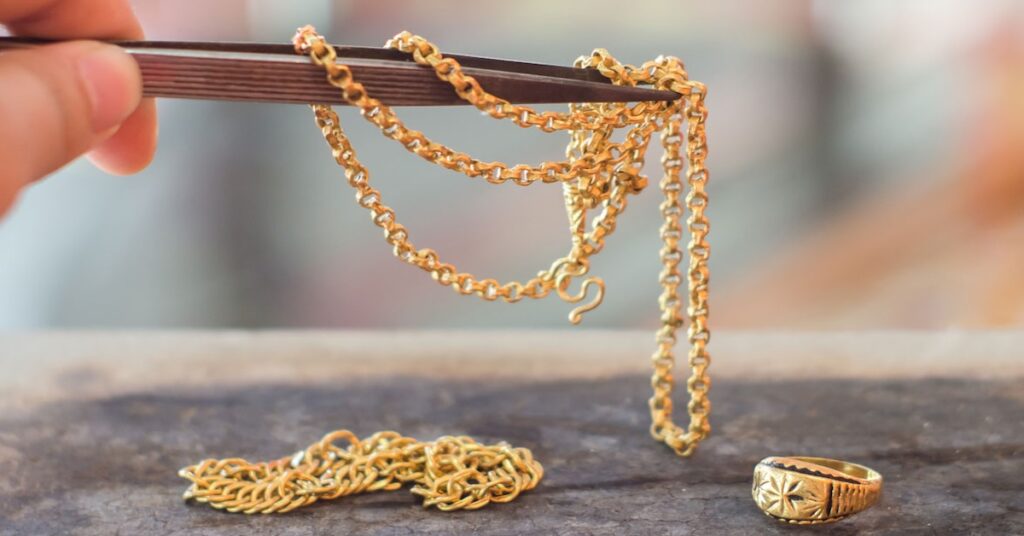Inheriting gold jewelry can bring up a lot of questions. Some pieces might be stunning heirlooms you’d never part with, while others are outdated, broken, or not your style. If you’re not interested in keeping all of it, you might be wondering whether you should melt the gold down for its metal value or sell the items as they are. The right answer depends on a few things, including the condition of the jewelry, its historical or sentimental value, and what you hope to get out of the process.

Take Time to Understand What You’ve Got
Before making any decisions, sort through the jewelry and take a closer look. Is anything clearly labeled with purity marks like 10k, 14k, or 18k? Are there gemstones, designer stamps, or antique features? Try to separate wearable, intact pieces from broken or mismatched ones. Even if something looks unremarkable, it could be more valuable than it seems — especially if it was handmade, signed by a known designer, or has vintage appeal.
You don’t need to be an expert, but having a general idea of what you’re working with helps avoid costly mistakes later.
What Does It Mean to Melt Gold?
Melting down gold is usually done through a refinery or precious metal buyer. They weigh the gold, test its purity, and melt it to extract the raw material. This process removes any stones or settings and pays you based on the gold content, not the beauty of the piece.
Keep in mind, the payout for melted gold is often a percentage of the market rate, not the full value. Refineries may charge processing fees, and what you walk away with is typically based on the melt value after those costs.
When Melting Makes the Most Sense
If you have broken chains, single earrings, or heavily worn rings that aren’t valuable as finished jewelry, melting might be the right call. This option can also be useful if you’ve inherited many small pieces that are mismatched or beyond repair. Some people also choose to melt jewelry to eliminate emotional attachment, especially when the items come from a complicated or painful family situation.
In these cases, melting provides a clean break and a straightforward way to turn unused items into cash.
But There Are Downsides You Shouldn’t Ignore
Once you melt a piece of jewelry, it’s gone for good. There’s no undoing the process, so it’s worth thinking twice before melting something with family history or sentimental value. You also lose any potential collectible or designer worth that the item might have had. For example, a signed vintage bracelet might bring in more from a collector than you’d ever get by weight alone.
If a piece looks unique or well-crafted, it’s worth getting it appraised before deciding to melt it down.
Selling Jewelry As-Is Could Be More Profitable
Many items hold value beyond the gold content. Jewelry from well-known designers, antique pieces, or anything with gemstones could fetch more if sold intact. Buyers often pay a premium for craftsmanship, design, and rarity. Local jewelers, vintage boutiques, and even online marketplaces can be good places to explore if you’re considering selling items as finished jewelry.
Sometimes, even simple but elegant designs can outperform their melt value just because they’re still wearable and in demand.
Not Sure What’s Worth Selling Whole?
Look for any signatures or maker’s marks — especially on rings, brooches, or older pieces. Items with gemstones, even small ones, should be checked for authenticity. Diamonds, sapphires, and emeralds in particular can increase the overall value.
A professional appraisal will give you a clearer picture. Even a quick evaluation from a trusted jeweler or coin dealer can help determine whether it’s worth selling the item as-is or melting it down.
Always Shop Around for the Best Offer
Don’t settle for the first number someone throws at you. Get multiple quotes from different sources. Some buyers specialize in raw gold, while others focus on vintage or designer jewelry. Be clear about what each buyer is offering, and ask for a breakdown: are they paying by weight, design, or gemstone value?
Weight your gold yourself if you can, and check the current gold price online. This gives you a better idea of what’s fair and what’s not.
There Might Be Tax Implications Too
Selling inherited gold isn’t always tax-free. Depending on how much you make and when you sell, you might be responsible for capital gains tax. This is especially true if the value of the gold has gone up significantly since the time it was inherited. Talking to a tax advisor or accountant can help clear things up before you commit to a big sale.
Don’t Forget Sentimental Value
Just because a piece isn’t your style doesn’t mean it has no worth. Some items tell a family story, and once they’re gone, you can’t get them back. If you’re unsure, consider holding onto a few meaningful pieces and selling the rest. Another option is to have older gold jewelry reworked into something new that you’ll actually wear. That way, you keep the memory but update the look.
Think It Through and Make a Smart Move
At the end of the day, there’s no one-size-fits-all answer. Melting gold might be right for broken or outdated items, while selling as-is could be better for anything with design or historical value. What matters most is understanding what you’ve inherited and weighing your options before jumping in.
At DMK Metal, we help people make informed decisions about their precious metals. Whether you’re thinking about melting old jewelry or exploring its resale value, we offer honest advice, fair appraisals, and a pressure-free experience. Bring us your collection — we’ll help you figure out the best path forward.
